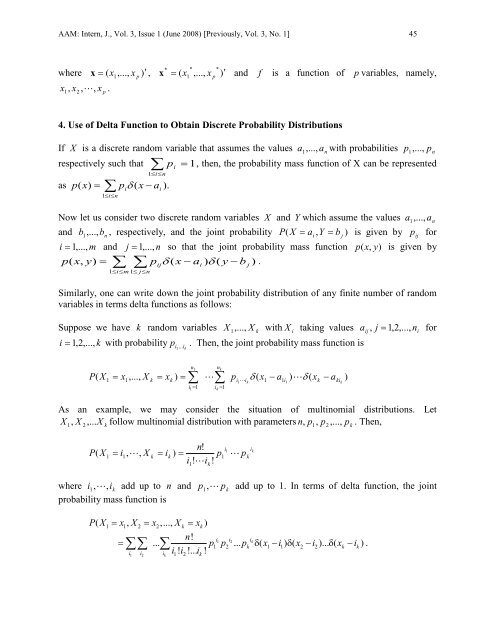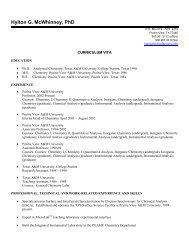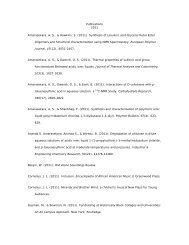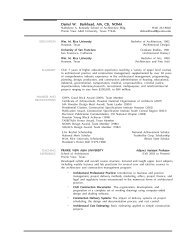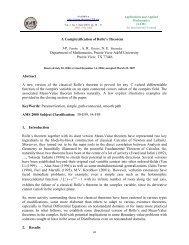Some applications of Dirac's delta function in Statistics for more than ...
Some applications of Dirac's delta function in Statistics for more than ...
Some applications of Dirac's delta function in Statistics for more than ...
Create successful ePaper yourself
Turn your PDF publications into a flip-book with our unique Google optimized e-Paper software.
AAM: Intern, J., Vol. 3, Issue 1 (June 2008) [Previously, Vol. 3, No. 1] 45<br />
where x = ( x1<br />
,..., x ) ′ p ,<br />
* *<br />
= ( 1 ,..., ) ′ p x x<br />
*<br />
x and f is a <strong>function</strong> <strong>of</strong> p variables, namely,<br />
x x , , x .<br />
1, 2<br />
p<br />
4. Use <strong>of</strong> Delta Function to Obta<strong>in</strong> Discrete Probability Distributions<br />
If X is a discrete random variable that assumes the values n a a 1,..., with probabilities n p p 1 ,...,<br />
respectively such that ∑ pi<br />
= 1, then, the probability mass <strong>function</strong> <strong>of</strong> X can be represented<br />
1≤i≤<br />
n<br />
as p(<br />
x)<br />
= ∑ piδ<br />
( x − ai<br />
).<br />
1≤i≤n<br />
Now let us consider two discrete random variables X and Y which assume the values n a a 1 ,...,<br />
and n b b 1 ,..., , respectively, and the jo<strong>in</strong>t probability P ( X = ai<br />
, Y = b j ) is given by p ij <strong>for</strong><br />
i = 1,...,<br />
m and j = 1,...,<br />
n so that the jo<strong>in</strong>t probability mass <strong>function</strong> p ( x,<br />
y)<br />
is given by<br />
p( x,<br />
y)<br />
p δ ( x − a ) δ ( y − b ) .<br />
= ∑ ∑<br />
1≤i≤m 1≤<br />
j≤n<br />
ij<br />
i<br />
Similarly, one can write down the jo<strong>in</strong>t probability distribution <strong>of</strong> any f<strong>in</strong>ite number <strong>of</strong> random<br />
variables <strong>in</strong> terms <strong>delta</strong> <strong>function</strong>s as follows:<br />
j<br />
Suppose we have k random variables k X X 1 ,..., with X i tak<strong>in</strong>g values a ij , j = 1,<br />
2,...,<br />
ni<br />
<strong>for</strong><br />
i = 1,<br />
2,...,<br />
k with probability k i i p 1 ... . Then, the jo<strong>in</strong>t probability mass <strong>function</strong> is<br />
n<br />
1<br />
k<br />
P( X = x1,...,<br />
X k = xk<br />
) = ∑ ∑ pi<br />
( ) (<br />
1<br />
i δ x k 1 − a1i<br />
δ<br />
x<br />
1<br />
k − a<br />
n<br />
1 kik<br />
i1<br />
= 1 ik<br />
= 1<br />
As an example, we may consider the situation <strong>of</strong> mult<strong>in</strong>omial distributions. Let<br />
X X ,... X<br />
n p , p ,..., p . Then,<br />
1, 2 k follow mult<strong>in</strong>omial distribution with parameters , 1 2 k<br />
n!<br />
i1<br />
P( X 1 = i1,<br />
,<br />
X k = ik<br />
) = p1<br />
p<br />
i ! i<br />
!<br />
1<br />
k<br />
ik<br />
k<br />
where i 1, , ik<br />
add up to n and k p p , 1 add up to 1. In terms <strong>of</strong> <strong>delta</strong> <strong>function</strong>, the jo<strong>in</strong>t<br />
probability mass <strong>function</strong> is<br />
PX ( 1 = x1, X2 = x2,..., Xk = xk)<br />
= ...<br />
n!<br />
i1 i2<br />
ik<br />
p1 p2 ... pk δ( x1−i1) δ( x2 −i2)... δ( xk −ik)<br />
i ! i !... i !<br />
∑∑ ∑ .<br />
i1 i2 ik1 2 k<br />
)


